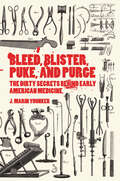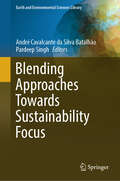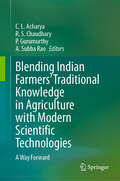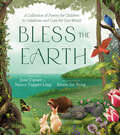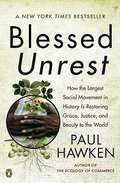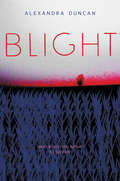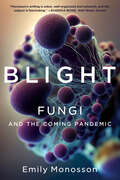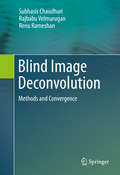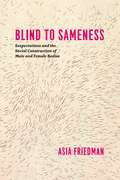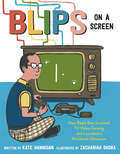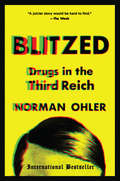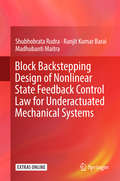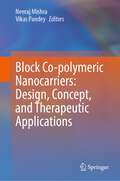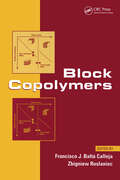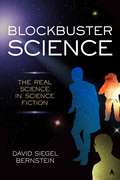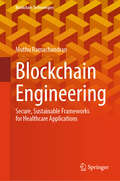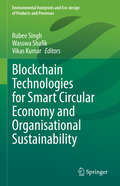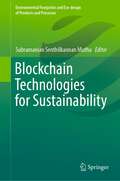- Table View
- List View
Bleach Plant Effluents from the Pulp and Paper Industry (SpringerBriefs in Applied Sciences and Technology)
by Pratima BajpaiThis book covers bleach plant effluents, that most polluting effluent from the pulp and paper industry. Disappearance of benthic invertebrates, a high incidence of fish diseases, and mutagenic effects on the aquatic fauna are some of the consequences of the disposal of bleach effluents into surface waters. This book describes environmental impact of bleach plant effluents, environmental regulations, and measures to reduce the pollution load by internal process modification and external treatment of bleach plant effluents.
Bleak Joys: Aesthetics of Ecology and Impossibility (Posthumanities #53)
by Matthew Fuller Olga GoriunovaA philosophical and cultural distillation of the bleak joys in today&’s ambivalent ecologies and patterns of lifeBleak Joys develops an understanding of complex entities and processes—from plant roots to forests to ecological damage and its calculation—as aesthetic. It is also a book about &“bad&” things, such as anguish and devastation, which relate to the ecological and technical but are also constitutive of politics, the ethical, and the formation of subjects.Avidly interdisciplinary, Bleak Joys draws on scientific work in plant sciences, computing, and cybernetics, as well as mathematics, literature, and art in ways that are not merely illustrative of but foundational to our understanding of ecological aesthetics and the condition in which the posthumanities are being forged. It places the sensory world of plants next to the generalized and nonlinear infrastructure of irresolvability—the economics of indifference up against the question of how to make a home on Planet Earth in a condition of damaged ecologies. Crosscutting chapters on devastation, anguish, irresolvability, luck, plant, and home create a vivid and multifaceted approach that is as remarkable for its humor as for its scholarly complexity.Engaging with Deleuze, Guattari, and Bakhtin, among others, Bleak Joys captures the modes of crises that constitute our present ecological and political condition, and reckons with the means by which they are not simply aesthetically known but aesthetically manifest.
Bleed, Blister, Puke, and Purge: The Dirty Secrets Behind Early American Medicine
by J. Marin YounkerRiots over the medical use of cadavers, public access to institutions for the insane, and full-blown surgeries without the aid of anesthetics or painkillers. Welcome to the middle ages of American medicine. Bleed, Blister, Puke, and Purge exposes the extraordinary practices and major players of American medical history, from America's colonial era to the late 1800s. It's hard to believe that today's cutting-edge medicine originated from such crude beginnings, but this book reminds us to be grateful for today's medical care, while also raising the question: what current medical practices will be the horrors of tomorrow?
Blending Approaches Towards Sustainability Focus (Earth and Environmental Sciences Library)
by Pardeep Singh André Cavalcante da Silva BatalhãoIn an era defined by environmental challenges and the urgent need for sustainable practices, this book emerges as a groundbreaking resource for public and private organizations, practitioners, users of environmental services, and professionals in the fields of environmental sciences, engineering sciences, and business sciences. This thought-provoking book delves into the intricate realm of sustainability, offering profound insights, theoretical frameworks, and practical solutions that can be applied across diverse sectors and systems worldwide. Purpose and the Need for a New Resource: Authored with a visionary perspective, this book aims to catalyze change and inspire action in the face of pressing global challenges. The urgency of addressing energy transition, waste management, sustainable supply chain, and circular economy has never been more evident. As we navigate a world grappling with climate change, resource depletion, and ecological degradation, there is a critical need for a comprehensive and up-to-date resource that provides both theoretical foundations and technical guidance on sustainable practices. This book fills a crucial gap in the literature by addressing these pressing concerns and equipping readers with the knowledge and tools necessary to foster a sustainable future. By amalgamating insights from environmental, engineering, and business sciences, "Sustainable Futures" offers a multidisciplinary approach, presenting a holistic understanding of sustainability and its interconnectedness with various sectors and systems. Solving Problems for Readers: The book illuminates the theoretical underpinnings of sustainability while equipping readers with tangible mechanisms for transformative action. By bridging the gap between theory and practice, this book empowers practitioners and professionals alike to implement sustainable strategies and initiatives within their organizations. Moreover, this book recognizes the need for context-specific approaches, acknowledging the diverse range of systems and sectors around the world.
Blending Indian Farmers' Traditional Knowledge in Agriculture with Modern Scientific Technologies: A Way Forward
by C. L. Acharya R. S. Chaudhary P. Gurumurthy A. Subba RaoThis book is a compilation of 37 chapters covering various agro ecosystems of India with respect to Indian farmers’ traditional knowledge and technology in agriculture specifically in nutrient management, crop production, water management and conservation, soil conservation and plant protection, which have been passed on from one generation to other since centuries. The book explains the scopes of blending this traditional knowledge with modern scientific technologies in agriculture with an aim of reducing production cost, improving soil health and use efficiency of costly market purchased inputs, water conservation and better environment. In the present era of continued degradation of natural resources of India, (primarily soil, water, and nutrients), falling soil health, poor use efficiency of agricultural inputs like fertilizer nutrients imported/ purchased at huge costs, it has become a big challenge to maintain the food production and simultaneously to sustain the soil health and productivity. The problem is further made complex by the changing climate, high levels of soil erosion and rising demands of ever-increasing population of the country for food, fodder, fibre, and fuel. In the face of such an alarming situation, the blending of low-cost traditional knowledge of Indian farmers and use of locally available inputs/ resources with the modern scientific technologies in agriculture, is seen as a major hope in increasing the input use efficiency, protection/conservation of the soil, water and nutrients towards sustainable crop production and food security without compromising the soil health. The book will be of interest to the scientists/researchers, extension workers, capacity builders, planners, government administrators, teachers, and students.
Blends and Graft Copolymers of Cellulosics: Toward the Design and Development of Advanced Films and Fibers (SpringerBriefs in Molecular Science)
by Yoshiyuki Nishio Yoshikuni Teramoto Ryosuke Kusumi Kazuki Sugimura Yoshitaka AranishiThis book reveals how polymer blending and grafting now offer a growing range of new applications for advanced films and fibers. Further, it details how the processing and original physical properties of cellulosics can be improved, and demonstrates how new, cellulose-core polymeric materials offer a wide range of synergistic functionalities. Lastly, it summarizes basic characterization studies and successful fabrications of advanced films and fibers. The book is primarily intended for advanced undergraduates, academic and industrial researchers and professionals studying or using bio-based polymers.
Bless the Earth: A Collection of Poetry for Children to Celebrate and Care for Our World
by June Cotner Nancy Tupper LingA beautifully illustrated collection of poems and prayers to help children develop an appreciation for the natural worldBless the Earth, our faithful friend,her mountain range and river bend,her forest green and canopy,the hidden world of bended trees. Bless the Earth shows the miracle of our planet Earth through beautiful imagery and delightful poetry, calling all people, young and old, to care for our wonderful world. This sweet and welcoming anthology for children ages 3-7 knits together our common humanity and the natural world in an engaging way that is simple for young readers to understand.Bless the Earth contains approximately sixty selections of original as well as classic poems, divided into five chapters each:Dreams for My WorldEarth and SkyAll Creatures, Big and SmallSeasonsCaring for Our World Bless the Earth calls us again and again to understand how important it is to care for our world, respect our neighbors—humans, plants, and animals alike—and reimagine a world that is healthy and whole.
Blessed Unrest
by Paul HawkenOrganizations working to restore the environment and foster social justice collectively comprise the largest movement on earth. This movement with no name, leader, or location is a creative expression of people's needs worldwide.
Blight
by Alexandra DuncanWhen an agribusiness facility producing genetically engineered food releases a deadly toxin into the environment, seventeen-year-old Tempest Torres races to deliver the cure before time runs out.From the author of the acclaimed American Booksellers Association’s Indies Introduce pick Salvage, which was called “Brilliant, feminist science fiction” by Stephanie Perkins, the internationally bestselling author of Anna and the French Kiss. This stand-alone action-adventure story is perfect for fans of Oryx and Crake and The House of the Scorpion. Seventeen-year-old Tempest Torres has lived on the AgraStar farm north of Atlanta, Georgia, since she was found outside its gates at the age of five. Now she’s part of the security force guarding the fence and watching for scavengers—people who would rather steal genetically engineered food from the Company than work for it. When a group of such rebels accidentally sets off an explosion in the research compound, it releases into the air a blight that kills every living thing in its path—including humans. With blight-resistant seeds in her pocket, Tempest teams up with a scavenger boy named Alder and runs for help. But when they finally arrive at AgraStar headquarters, they discover that there’s an even bigger plot behind the blight—and it’s up to them to stop it from happening again.Inspired by current environmental issues, specifically the genetic adjustment of seeds to resist blight and the risks of not allowing natural seed diversity, this is an action-adventure story that is Margaret Atwood’s Oryx and Crake meets Nancy Farmer’s House of the Scorpion.
Blight: Fungi and the Coming Pandemic
by Emily MonossonWinner of the 2024 Phi Beta Kappa Award for Science A New York Times Editors' Choice A Science News Favorite Book of 2023 "Fungi sicken us and fungi sustain us. In either case, we ignore them at our peril." —Elizabeth Kolbert, New York Review of Books A prescient warning about the mysterious and deadly world of fungi—and how to avert further loss across species, including our own. Fungi are everywhere. Most are harmless; some are helpful. A few are killers. Collectively, infectious fungi are the most devastating agents of disease on earth, and a fungus that can persist in the environment without its host is here to stay. In Blight, Emily Monosson documents how trade, travel, and a changing climate are making us all more vulnerable to invasion. Populations of bats, frogs, and salamanders face extinction. In the Northwest, America’s beloved national parks are covered with the spindly corpses of whitebark pines. Food crops are under siege, threatening our coffee, bananas, and wheat—and, more broadly, our global food security. Candida auris, drug-resistant and resilient, infects hospital patients and those with weakened immune systems. Coccidioides, which lives in drier dusty regions, may cause infection in apparently healthy people. The horrors go on. Yet prevention is not impossible. Tracing the history of fungal spread and the most recent discoveries in the field, Monosson meets scientists who are working tirelessly to protect species under threat, and whose innovative approaches to fungal invasion have the potential to save human lives. Delving into case studies at once fascinating, sobering, and hopeful, Blight serves as a wake-up call, a reminder of the delicate interconnectedness of the natural world, and a lesson in seeing life on our planet with renewed humility and awe.
Blind Image Deconvolution: Methods and Convergence
by Subhasis Chaudhuri Rajbabu Velmurugan Renu RameshanBlind deconvolution is a classical image processing problem which has been investigated by a large number of researchers over the last four decades. The purpose of this monograph is not to propose yet another method for blind image restoration. Rather the basic issue of deconvolvability has been explored from a theoretical view point. Some authors claim very good results while quite a few claim that blind restoration does not work. The authors clearly detail when such methods are expected to work and when they will not. In order to avoid the assumptions needed for convergence analysis in the Fourier domain, the authors use a general method of convergence analysis used for alternate minimization based on three point and four point properties of the points in the image space. The authors prove that all points in the image space satisfy the three point property and also derive the conditions under which four point property is satisfied. This provides the conditions under which alternate minimization for blind deconvolution converges with a quadratic prior. Since the convergence properties depend on the chosen priors, one should design priors that avoid trivial solutions. Hence, a sparsity based solution is also provided for blind deconvolution, by using image priors having a cost that increases with the amount of blur, which is another way to prevent trivial solutions in joint estimation. This book will be a highly useful resource to the researchers and academicians in the specific area of blind deconvolution.
Blind to Sameness: Sexpectations and the Social Construction of Male and Female Bodies
by Asia FriedmanWhat is the role of the senses in how we understand the world? Cognitive sociology has long addressed the way we perceive or imagine boundaries in our ordinary lives, but Asia Friedman pushes this question further still. How, she asks, did we come to blind ourselves to sex sameness? Drawing on more than sixty interviews with two decidedly different populations—the blind and the transgendered—Blind to Sameness answers provocative questions about the relationships between sex differences, biology, and visual perception. Both groups speak from unique perspectives that magnify the social construction of dominant visual conceptions of sex, allowing Friedman to examine the visual construction of the sexed body and highlighting the processes of social perception underlying our everyday experience of male and female bodies. The result is a notable contribution to the sociologies of gender, culture, and cognition that will revolutionize the way we think about sex.
Blinded By The Light: The Secret Life of the Sun
by John GribbinIn investigation into the study of the sun.
Blip, Ping, and Buzz: Making Sense of Radar and Sonar
by Mark DennyHave you ever wondered how stealth planes achieve "invisibility," how sunken ships are found, or how fishermen track schools of fish in vast expanses of ocean? Radar and sonar echolocation—a simple matter of sending, receiving, and processing signals.Weaving history with simple science, Mark Denny deftly reveals the world of radar and sonar to the curious reader, technology buff, and expert alike. He begins with an early history of the Chain Home radar system used during World War II and then provides accessible and engaging explanations of the physics that make signal processing possible. Basic diagrams and formulas show how electromagnetic and sound waves are transmitted, received, and converted into images, allowing you to literally see in the dark.A section on bioacoustic echolocation, with a focus on the superior sonar systems of bats and whales and a discussion of the advanced technology of next-generation airborne signal processors, opens the imagination to fascinating possibilities for the future.
Blips on a Screen: How Ralph Baer Invented TV Video Gaming and Launched a Worldwide Obsession
by Kate HanniganAn engaging picture book biography based on the incredible true story of a Jewish refugee who pioneered home video games and launched a worldwide obsession.Do you ever wonder how video gaming was invented? What came before your PlayStation or Xbox? This is the story of Ralph Baer, a refugee from Nazi Germany, who used his skills--and a lot of ingenuity and persistence--to make life a little more fun. Television was new when Ralph returned from serving in World War II, but he didn't settle for watching TV. He knew it could be even more fun if you could play with it. He tinkered and tested, got help and rejected, but with perseverance and skill, he made his vision come true! This is the inspiring story of a fearless inventor who made TV video games a reality.
Blitzed: Drugs in the Third Reich
by Norman OhlerA New York Times bestseller, Norman Ohler's Blitzed is a "fascinating, engrossing, often dark history of drug use in the Third Reich” (Washington Post). The Nazi regime preached an ideology of physical, mental, and moral purity. Yet as Norman Ohler reveals in this gripping history, the Third Reich was saturated with drugs: cocaine, opiates, and, most of all, methamphetamines, which were consumed by everyone from factory workers to housewives to German soldiers. In fact, troops were encouraged, and in some cases ordered, to take rations of a form of crystal meth—the elevated energy and feelings of invincibility associated with the high even help to account for the breakneck invasion that sealed the fall of France in 1940, as well as other German military victories. Hitler himself became increasingly dependent on injections of a cocktail of drugs—ultimately including Eukodal, a cousin of heroin—administered by his personal doctor. Thoroughly researched and rivetingly readable, Blitzed throws light on a history that, until now, has remained in the shadows. “Delightfully nuts.”—The New Yorker
Block Backstepping Design of Nonlinear State Feedback Control Law for Underactuated Mechanical Systems
by Ranjit Kumar Barai Shubhobrata Rudra Madhubanti MaitraThis book presents a novel, generalized approach to the design of nonlinear state feedback control laws for a large class of underactuated mechanical systems based on application of the block backstepping method. The control law proposed here is robust against the effects of model uncertainty in dynamic and steady-state performance and addresses the issue of asymptotic stabilization for the class of underactuated mechanical systems. An underactuated system is defined as one for which the dimension of space spanned by the configuration vector is greater than that of the space spanned by the control variables. Control problems concerning underactuated systems currently represent an active field of research due to their broad range of applications in robotics, aerospace, and marine contexts. The book derives a generalized theory of block backstepping control design for underactuated mechanical systems, and examines several case studies that cover interesting examples of underactuated mechanical systems. The mathematical derivations are described using well-known notations and simple algebra, without the need for any special previous background in higher mathematics. The chapters are lucidly described in a systematic manner, starting with control system preliminaries and moving on to a generalized description of the block backstepping method, before turning to several case studies. Simulation and experimental results are also provided to aid in reader comprehension.
Block Co-polymeric Nanocarriers: Design, Concept, and Therapeutic Applications
by Neeraj Mishra Vikas PandeyThis book focuses on current advancements in the field of block copolymers and covers design, concept, and various therapeutic applications in the drug delivery. It also reviews the use of block copolymers in drug delivery applications from the development of sustained release products to smart polymeric delivery systems such as stimuli-responsive polymeric systems, for example, thermosensitive, redox-sensitive, photo-sensitive, and enzyme-sensitive. The book further discusses the nano assemblies from amphiphilic block copolymers as nanomedicine platforms for diagnosis and therapy due to their relatively small size, high drug loading capacity, controlled drug release, in vivo stability, and prolonged blood circulation. The chapters also review the various patents and ongoing clinical trials on the applications, covering several important new concepts and findings in the field of block copolymers. The book is aimed at researchers, academicians, and industrial scientists involved in the development of drug-delivery systems based on polymers.
Block Copolymers
by Francisco J. Baltá Calleja Zbigniew RoslaniecA summary of block copolymer chemical structures and synthesis. It discusses physical methods of characterization such as computer simulation, microhardness, dielectric spectroscopy, thermal mechanical relaxation, ultrasonic characterization, transmission electron microscopy, X-ray scattering, and NMR, among others. It also outlines rheological and
Blockbuster Science: The Real Science in Science Fiction
by David Siegel BernsteinIf you've ever wondered how much real science goes into movies like Gravity, novels like The Martian, and television shows like Doctor Who, this is the book for you. Written by an author who is both a data scientist and a science fiction writer, this entertaining and accessible book uses popular science fiction movies, stories, and TV shows to explain the science behind popular narrative concepts like time travel, lightsabers, AI, genetic mutation, asteroids, cyborgs, black holes, alien invasion, the zombie apocalypse, and more.What could be a more fun way to explore the world of science than through its use—accurately or fantastically—in science fiction entertainment: movies, books, and TV shows?Learn about relativity through Orson Scott Card's Ender's Game and the movie Interstellar; black holes and wormholes in connection with Contact and Planet of the Apes; theories about the origin of life as reflected in Battlestar Galactica, Star Trek: The Next Generation, and The Hitchhiker's Guide to the Galaxy; computer science and artificial intelligence in reference to A.I. Artificial Intelligence; and much, much, more.Written with wit, clarity, and a great sense of fun, Blockbuster Science will inspire science fiction fans to get excited about real science while also putting an engaging pop culture spin on science for any curious reader.
Blockchain Applications in Food Supply Chain Management: Case Studies and Implications (Contributions to Management Science)
by Steve Brown Chen Zhang Yu GongThis book contributes to blockchain applications in food supply chain management from both theoretical and practical perspectives. By using the case study research method, it empirically investigates why and how food companies implement blockchain technology. Moreover, it proposes a conceptual framework based on the case findings and extant literature. The book provides empirical evidence to verify academic findings such as critical success factors and barriers. Furthermore, it identifies the implementation process to answer the ‘how’ question. Uniquely, it applies the innovation process model and the practice-based view (PBV) to studies on food supply chains and blockchain. Thus, building on the original model and theory, it enriches the theory on blockchain implementation, making it a valuable asset for all researchers and practitioners interested in blockchain adoption and food supply chain management.
Blockchain Engineering: Secure, Sustainable Frameworks for Healthcare Applications (Blockchain Technologies)
by Muthu RamachandranThis book provides a comprehensive guide to the principles and engineering approaches necessary for developing secure and sustainable blockchain applications. It introduces fundamental blockchain concepts and explores the integration of AI and blockchain. Targeted at students, IT professionals, managers, and healthcare practitioners, this book seeks to empower readers to effectively leverage blockchain technology.
Blockchain Governance (The MIT Press Essential Knowledge series)
by Primavera De Filippi Wessel Reijers Morshed MannanAn engaging and comprehensive exploration of how fundamental ideas in political and legal thought shape the governance of blockchain communities, and are, in turn, shaped by blockchain technology.How can digital cash truly be “trustless”? What does it mean that blockchain offers a new paradigm of the “rule of code”? How are decisions made when a blockchain system faces an emergency, and who gets to make those decisions? In Blockchain Governance, Primavera De Filippi, Wessel Reijers, and Morshed Mannan offer answers to these questions and more, in an accessible, critical overview of legal and political issues related to blockchain technology, now the foundation of a multi-billion-dollar industry. Moving beyond the hype, they show how blockchain offers fertile ground for experimentation with radically new ways to govern people and institutions. Blockchain-based systems, like Bitcoin, Ethereum, Tezos, and countless others, offer new ways of organizing digital cash, “smart” contracts to execute transactions, non-fungible tokens (NFTs) to collect art, and decentralized autonomous organizations (DAOs) to coordinate humans and machines. What these applications have in common is that they govern the behavior of people and artificial agents through distributed systems. Drawing from their extensive experience in researching blockchain technologies and communities, the authors discuss the origins of Bitcoin in cypher-anarchism and extropianism, spectacular events like the million-dollar theft of the DAO Attack, and the hostile takeover of the Steem platform. While engaging with political and legal thinkers such as Hobbes, Kelsen, and the Ostroms, these narratives explore how blockchain governance problematizes fundamental concepts such as rule of law, sovereignty, legality, legitimacy, and polycentric governance.
Blockchain Technologies for Smart Circular Economy and Organisational Sustainability (Environmental Footprints and Eco-design of Products and Processes)
by Vikas Kumar Rubee Singh Wasswa ShafikThis book provides a descriptive overview of blockchain technology domain, we observe a transformative influence that has surpassed its initial application in Bitcoin and has permeated nearly all industries. The utilisation of distributed ledger technology presents a significant transformation in the realm of data management, trust, and transparency. Its impact extends beyond financial transactions and encompasses other domains like supply chain optimization, identity verification, and the development of decentralized apps. The process of transformation has been initiated in various industries, including finance, healthcare, and logistics. In contrast, there is a notable increase in the adoption of the smart circular economy frameworks as a response to the heightened acknowledgment of the environmental and resource-related obstacles linked to the traditional linear paradigm of "extract, produce, discard." The primary objective of the circular economy is to limit the generation of waste, advance sustainable product design, and promote responsible resource utilization through the facilitation of recycling, remanufacturing, and the prolongation of product lifespans. This movement holds significance for various industries, including manufacturing, waste management, and sustainable consumerism, due to its wide-ranging ramifications. Its unique characteristic is its capacity to connect these two realms, emphasizing the potential of blockchain technology in facilitating transparent data management and smart contracts to advance the concepts of the circular economy. The book offers a thorough examination of the topic, offering readers a grasp of the fundamental principles of blockchain as well as the dynamic field of sustainability. This renders it an indispensable reference for individuals interested in the interdisciplinary ramifications of technology on sustainability, and the transformative possibilities of blockchain within the realm of resource-efficient and environmentally conscious approaches. The book exemplifies a progressive perspective by demonstrating the significant role that inventive technology can assume in tackling the urgent issues of our era, revolutionising sectors, and influencing the trajectory of a more circular and environmentally conscious global society.
Blockchain Technologies for Sustainability (Environmental Footprints and Eco-design of Products and Processes)
by Subramanian Senthilkannan MuthuThis book highlights the applications of blockchain technologies to foster sustainable development in different fields. The concept of Sustainability has grown widespread in today’s context and there are many requirements to achieve Sustainability in any industrial sector including mapping, tracing the supply chain to ensure sustainable supply chain management. Reliable and transparent, efficient data is one of the key requirements for Sustainability in today’s advanced industrial context. Achievement of Sustainability objectives in this advanced era demands various technological advancements such as Blockchain technologies. The core competencies of blockchain technology namely transparency, data auditability, privacy, value transfer, and process efficiency and automation are very much essential for achieving the multifold objectives under sustainability.


